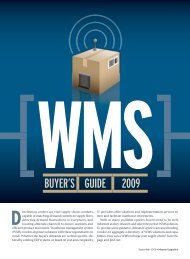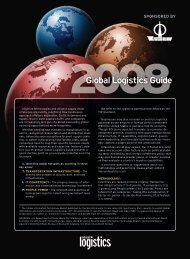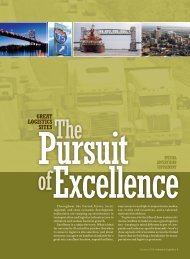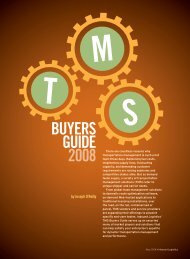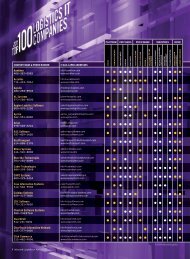Best Practices Playbook - Inbound Logistics
Best Practices Playbook - Inbound Logistics
Best Practices Playbook - Inbound Logistics
- No tags were found...
Create successful ePaper yourself
Turn your PDF publications into a flip-book with our unique Google optimized e-Paper software.
BESTPRACTICESWhether you’re adding a new 3PLplayer to your team or improvingyour transit time to goal, our guidewill coach you on game-winninglogistics moves.PLAYBOOKJuly 2009 • <strong>Inbound</strong> <strong>Logistics</strong>
DRAFT PICKSPlanning for the Turnover:Strategiesfor ChoosingTransportationPartnersEvaluate your transportation requirements to determine1 the following: your type of freight by mode; lead time withcarriers; territories and lanes being served; frequency ofvolume in lanes; and unique requirements, such as palletexchange or blanket wrap.Implement a core carrier program – concentrate service2 to a select number of capable, high-performance carriers.Guarantee them a portion of your projected volume inreturn for better rates and service quality commitment.Create an RFP that clearly states your requirements for3 bidding; for timing and response; and for the media tobe used in carrier presentations. Also include schedulerequirements, such as a time frame for solicitation and submission;carrier evaluation and selection; purchasing andcontracting procedures; and rate and terms negotiation.Select a group of carriers that most likely will meet your4 requirements. Access to a large group allows you to selectcarriers based on a set of filters.Standardize contract terms and requirements. Create a5 template to harmonize rate structures and accessorialcharges, and insist that carriers define rates and theircontext in common terms.Clearly state your performance expectations. Determine6 which attributes you will measure, such as on-timeperformance, acceptance rate, and equipment type andavailability.Outline your business process and communication7 methods. State whether you will use a software systemor manual processes; how you will perform tendering,acceptance, and timing; appointment scheduling; shipmentstatus and the required event reporting and timing; andsettlement.SPOTTING anAll-Star:Questions for prospectivecarriers★★ Does the carrier have sufficientcapacity to serve all yourtransportation needs?★★★★Is the carrier financially stable – noton the brink of insolvency – andwilling to reinvest in its businessand maintain the type of qualityequipment necessary to service yourneeds?Can the carrier supply referencesfrom businesses that are similar toyours?★★ Has the carrier made significanttechnology investments?★★★★★★★★Can the carrier provide real-timevisibility of shipment status andadvance warning of service failuresthat will allow you to respond to yourcustomers?Does the carrier have a centralizedcustomer service center withthe tools necessary to quicklycommunicate your needs and/orproblems to the proper location?If you require EDI for load tendering,shipment status, delivery notification,billing and/or remittance, can thecarrier support those needs?Does the carrier have quality billingprocesses?★★ Can the carrier provide you with thedocumentation you require?★★★★★★Can the carrier respond quickly toany special requests that you mayhave?If your equipment requirementschange, will the carrier be able tohandle it?If your customers need specialhandling, can the carrieraccommodate them, too?<strong>Inbound</strong> <strong>Logistics</strong> • July 2009
Kicking Off a 3PL RelationshipDrawing Up a Game Plan:How to Establish ExpectationsSend a Request for1 Information (RFI) before aRequest for Proposal (RFP).The RFI will help you collectbetter data, define your trueneeds, and involve your 3PLcandidates in developing asolution.Be forthcoming about issues2 that could affect your logisticsoperation. To get honestassessments, include issuesthat don’t necessarily makeyou look good or that areproprietary.Ask the 3PL for solutions in3 the RFP, leaving room for4creativity. Experienced 3PLscan add valuable consultingstrengths, creativity, andinnovations to the equation.Be specific. Give 3PLproviders detailed informationabout what you want them toaccomplish and be extremelycareful about making surethe providers fully understandthose expectations.Train your 3PL employees as5 if they were your own. Havepersonnel at your provider’sfulfillment center attend yourproprietary quality trainingcourse, and give them extrasystems training when youupgrade.Leveling the Playing Field:Getting the Most From an RFP12Be selective. If you send outRFPs in a cattle call, yourcandidates may not participateor respond with their “A”game. Nor will your internalteam be able to dedicate theproper time to evaluating eachresponse.Do your homework first. Issuean RFI, which is less timeconsumingto construct andrespond to than an RFP. Usethe data you collect to createa short list of five or fewercandidates for your RFP.Know your performance3 objectives. Solicit inputfrom all the key players inyour supply chain aboutthe performance, pricing,and productivity levels theyhope to achieve throughoutsourcing.Don’t ask the same old tired4 RFP questions. Weed out theweak ones, refine the keepers,and add some new ones toinspire insightful answers.5Keep it real. Be realisticabout how long you give candidatesto prepare a response.It takes time for 3PLs to runoptimizations and simulations,particularly if they’re creatingmultiple iterations.Surveying the Huddle: How toChoose a 3PL Without an RFPInstitute an internal 3PL1 evaluation team. Includerepresentation from the supplychain/logistics, informationtechnology, sales/marketing,purchasing, and financedepartments to ensurecorporate-wide buy-in for yourultimate decision.Create an enforceable, mutual2 non-disclosure agreement.Ask your legal departmentfor help with this documentbefore starting formalmeetings with your 3PLcandidates.Consider a maximum of three3 3PLs. Trying to thoroughlyevaluate more than threeservice providers could proveextremely demanding.Identify technology issues4 between your company andthe 3PLs. You may needto invest in technology tofully appreciate the benefitsavailable from a 3PL.Investigate what technologybenefits the 3PLs possessthat can work to youradvantage.Define a timetable for handing5 off responsibilities to the3PL, and document theresponsibilities you will retainin-house. The relationshipshould not be initiated untilthis process is in place.SCOUTINGJuly 2009 • <strong>Inbound</strong> <strong>Logistics</strong>
GAME PLANSFreight Management StrategiesCalling the Play:Initiating an Effective <strong>Inbound</strong> ProgramCreate an inbound logistics project team.1 Call on the expertise of your procurement andlogistics representatives, and draw on eachdepartment’s need for specific cost informationto better manage the process.2Define the project goals. Decide what youexpect to accomplish when the inboundprogram is completed.Determine key performance indicators (KPI).3 Create a baseline or benchmark of currentperformance, and determine KPI.Classify and quantify current inbound4 operations. Evaluate your current inboundshipments and classify by who controls thefreight (prepaid or collect), where the freightcosts lie, and whether the carrier is selected viaa routing guide.5Evaluate best landed cost by supplier. Tocalculate best landed cost, you must be ableto allocate freight charges plus fuel surchargesplus assessorials to get the true picture of yourcosts.The Heat is On:Shipping Temperature-Sensitive Products1Communicate your needs clearly. Spell outevery detail, even ones that may seem insignificant.Specify the acceptable temperature rangein degrees plus or minus the set point to ensurethe proper parameters are used, and indicateFahrenheit or Celsius.Maintain the temperature before and after2 transit. Shippers often stage temperaturesensitivefreight on a dock that is nottemperature-controlled. To ensure productquality, make sure your shipments remain in atemperature-controlled environment until thetruck is ready to be loaded. The drivers shouldalso keep the truck doors closed until the lastpossible moment to minimize any effect to thetemperature inside the cargo box.3Plan for less capacity. Temperature-controlledtrucks have less capacity. Cubic feet arereduced due to added insulation in the walls ofthe truck, and the added weight of temperaturecontrolequipment affects payload capability.Review packaging diagrams, dimensions,and weight requirements to avoid last-minutesurprises at the loading dock.TWO-MINUTEWARNINGManaging Expedited Shipments★★★★Hire the right people. Yourlogistics team should be able toeffortlessly evaluate a shipmentand convert it to the most costeffective– but expeditious – mode.Ensure visibility. To successfullymanage expedited shipments it isimperative that your system linkshippers, suppliers, and carriers.Customers need to see where theirfreight is every step of the way.★★★★Operate 24/7/365. Have an expeditedlogistics specialist available at all times toidentify and resolve any potential problemsthat may arise.Know your customers’ supply chain. Not allexpedited shipments are critical shipments.Understanding your customers’ supply chainenables you to provide flexible solutions.★★ Build a comprehensive coverage network.Many expedited shipments originate outsidecommon carrier lanes.Sources and Contributors: 3PD Inc., APL <strong>Logistics</strong>, FedEx Custom Critical, Franzetta Assoc., Insight Inc., Lean<strong>Logistics</strong>,NLM, Deborah Catalano Ruriani, Sterling Commerce, UPS<strong>Inbound</strong> <strong>Logistics</strong> • July 2009



